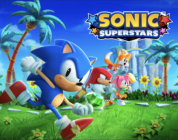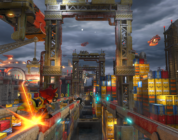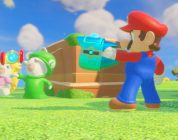Sekiro: Shadows Die Twice was released on March 22nd, 2019 – so why did I hold the review for this long? For me, Sekiro had a lot of stuff going on with it and it deserved proper time to not only fully explore, conquer, and master, but it also ate up a shit load of my time.
While working on my own playthrough, the internet went absolutely insane with articles about how Sekiro was too hard for normal people to play and that it needed a patch that granted an easy mode so everyone could enjoy it. After reaching the start of New Game ++ mode, I realized that Sekiro is actually already on easy mode from the very beginning. This sentence alone will probably infuriate people, but that’s the whole point and I’ll explain later but without question: This is 100% absolutely the worst game in the “Soulsborne” franchise/library.
Here’s why: Sekiro: Shadows Die Twice is an absolutely awful Dark Souls game — but it’s an absolutely incredible Tenchu game.
Dark Souls is a game where players move through areas with caution and prepare to fight anything and everything. Meanwhile in Bloodborne, there is an emphasis on dodging, parrying, and performing Visceral Attacks. Sure, there are similarities, but these mechanics aren’t the same in Sekiro: Shadows Die Twice.
Sekiro actively rewards the player with a considerably easier experience for using stealth, cunning, and tactics in order to get the drop on enemies. Going toe-to-toe with most enemies in this game actually creates a disadvantage, and that’s an extremely well thought out design that most people aren’t able to recognize. Think about it; in any setting, do you expect a Ninja or a Thief to be a tank?
Soulsborne games allows one to swap out abilities and stat points in order to specify what the player wants or needs to achieve a victory. Tanky battlemage can’t survive hits? Swap a little extra mana off for some more vitality or stamina. Sekiro doesn’t allow these options, because it’s not meant to.
Sekiro is a game that’s opposite of what we’ve continually been taught in these games. We have to re-learn what we already know and play this game in a defensive, strategic mindset in order to win.
Boss fights like Lady Butterfly encourage the player to use Snap Seeds to dismiss her shadow guardians while also using elements of the battle arena to avoid her homing missile attacks. The Wolf, also notably named Sekiro by Isshin Ashina, must use not only items found throughout the game’s world but also his own collection of learned moves, calculate Posture damage thresholds, and be able to react to enemy attack animations which let the player know if they should dodge, block, or perform a Mikiri Counter. Boss battles are ultimately the most dangerous games of Rock-Paper-Scissors ever.
So then, why can’t players re-spec their character? Well, that’s because From Software wants players to learn from their mistakes. It’s true that the lack of customization and gameplay options in Sekiro limits the replay value but there’s always more than one way to approach the problem at hand.
It’s extremely clear to fans of Tenchu that Sekiro was supposed to have been a Tenchu game but there’s also plenty of statements that prove this line of thinking as well. While Sekiro doesn’t limit us to dropping Caltrops and using whistles to lure enemies into traps, it does a tremendous job of benefiting players who move quickly on the rooftops to avoid enemies below or those who hide in tall grass in order to snatch the strongest enemy of the group for possession.
Sekiro gains tools to install into his prosthetic arm throughout his journey, as well as a number of different fighting style skills and a few Ninjutsu skills that can be used immediately after performing a deathblow. In fact, there’s even a mini-boss that is susceptible to the puppeteer skill, though it doesn’t really matter since there’s nothing but a few enemies that can be easily dispatched without using that skill, but it’s a cool trick nevertheless.
But wait, what’s that about the game being on easy mode? This game is hard AF. Ah yes, well, Sekiro is given a choice near the beginning of the game that will allow him to go through this journey on a considerately tougher path.
Too vague? Fine.
At the outset of the game, players start off by immediately searching for Kuro, the Divine Heir. After all, guarding him is Sekiro’s ultimate task, so it’s expected that you’d need to know where he’s at. When you find him, he’ll offer Sekiro his sword. However, after completing the game and starting New Game + (or starting a new save file for a regular New Game) Sekiro is given Kuro’s Charm. This can then be given to Kuro upon meeting him for the first time.
Giving Kuro his charm back will prompt the game to inform the player that they have chosen to walk the path of further hardships.
What this means is that Wolf will now take chip damage when blocking, meaning a loss of health AND posture damage for blocking, unless it’s timed perfectly so that it becomes a deflection. On top of this, enemies are given more posture and health and the player’s attacks do about half as much damage. Status afflictions also build up faster.
Ultimately, this transforms an extremely tough game into a seemingly impossible one.
While Sekiro: Shadows Die Twice is an excellent game, it’s not quite the masterpiece that the Soulsborne franchise is known for. While I have immense praise for the game, I’ve also spent enough time with it to fully explore and complete it. I have the Platinum trophy, as I have earned in all the other From Software titles available on the PS4 and after some reflection the biggest critique I have is this: Sekiro loses sight of what it actually is trying to be and that’s clear by how some of the battles play out.
It’s as if From Software made a Tenchu game and had fears that it wouldn’t sell well, so they put on some Dark Souls makeup and a sprinkle of Bushido Blade flavor to bring this soup to up to taste. While I much prefer the samurai combat battles, there are a few fights that are way too wheelhouse for Soulsborne and those take me completely out of the element, even though they are often fun boss fights.
Though I wish Sekiro: Shadows Die Twice didn’t feel ultimately rushed, it’s still a fantastic game – so long as it’s not compared to other Soulsborne games.
Sekiro: Shadows Die Twice was reviewed on the PlayStation 4 Pro. A digital copy was provided by Activision for the purpose of review.





